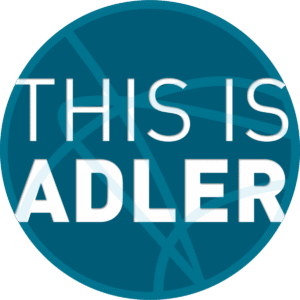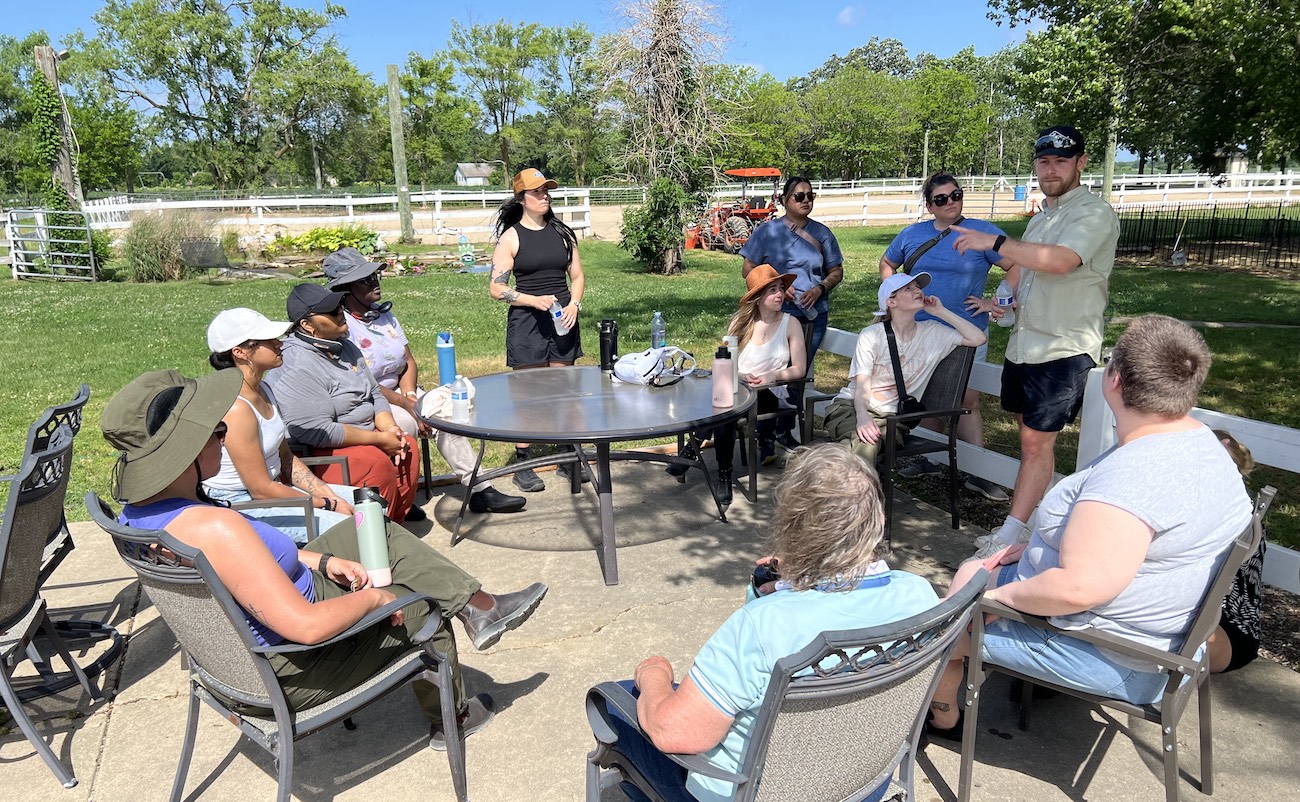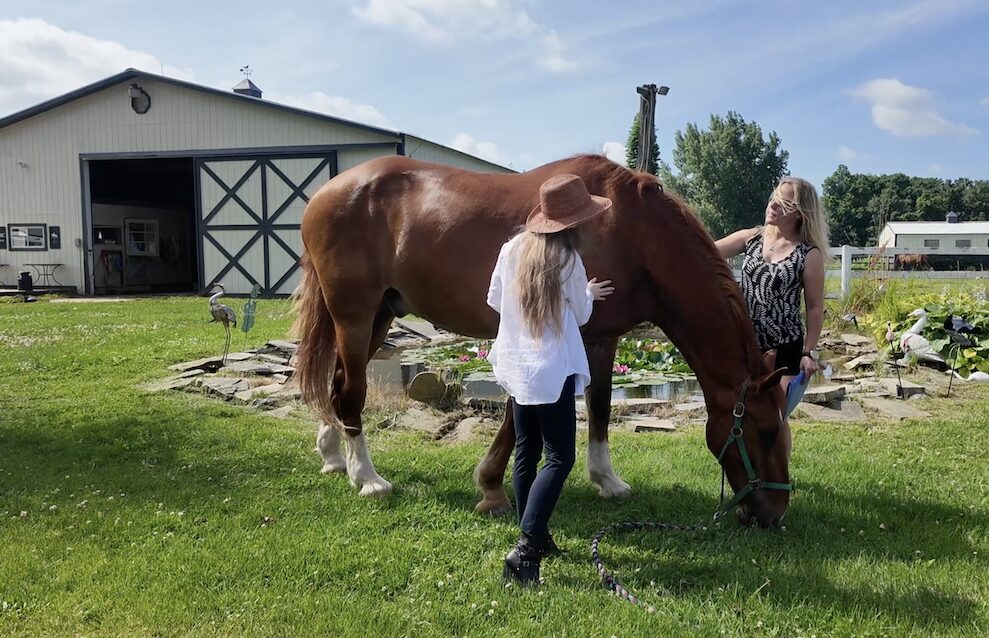
Editor’s note: Adler University offers a variety of unique learning experiences that train future practitioners to strengthen health outcomes. This Is Adler is a series that highlights the distinctive programs, courses, and individuals shaping how Adler’s foundation is Gemeinschaftsgefühl continues to influence systemic approaches to community well-being across the University.
Adler University students gathered around a patio table, under the shade of a tall tree while a strong breeze tried to keep them cool. By noon, it was nearly 88 degrees and rising at ERC Farms in Marengo, Illinois.
Three of the students had just completed an animal-assisted therapy exercise where they led Chief, a large copper-haired horse, through an outdoor obstacle course. Two students acted as therapists, working with Chief to help their client — the third student — explore his real-life anxiety about what comes next after completing graduate school.

The exercise is part of Adler University’s unique elective course in animal-assisted therapy (COUN 661) — one of several experiential offerings that challenge students to reimagine what clinical practice can look like. The course is led by Sandra Kakacek, Ed.D., associate professor in the Clinical Mental Health Counseling program and founder of ERC’s Fields for Growth program, who guides students through group debriefs after each session — encouraging them to reflect on the roles they played, the emotions surfaced, and how the animals’ responses opened new paths for understanding.
Following their work with Chief, the students discussed the open-ended questions they might have asked and considered how the horse’s navigation of the obstacle course reflected the client’s emotional experience.
“There’s just something very special about Chief,” said CMHC student Emily Challenger, who took on the role as one of the counselors. “He’s able to connect with people, helping them unearth their own trauma and feeling of stuck-ness.”
Expanding students’ clinical toolbox
It was the second weekend the classmates made the drive to the farm, nearly two hours northwest of Adler’s campus in Chicago.
With each visit across the course’s two-week period, students build on what they’ve learned — translating hands-on experience into clinical understanding grounded in course objectives.
Among the learning objectives for students are:
- Identify and apply the principals of animal-assisted therapy in counseling.
- Identify the clinical symptoms and current treatments in animal-assisted therapy in counseling.
- Demonstrate the application of metaphor construction and basic skills.
- Identify and apply herd dynamics and animal communication skills.
For many, it’s a transformative experience that expands their clinical toolbox and reshapes how they’ll connect with clients in the field.
Animal-assisted therapy is the use of any animal as a tool to increase mental health awareness. Modern use of the practice dates as early as 1699 in England and continued to evolve over the centuries.
Incorporating animals as a therapeutic toolbox is known to create physiological changes in clients, including increase in oxytocin for a calming effect, increase in endorphins for pleasure effect, and increase in dopamine which causes the reward center effect.
“Emotional changes can also result from animal interactions, including increased executive functioning, self-esteem, and sensory awareness, At Adler, we want our students to heighten their skills and think of creative ways that can help our clients.”
- – Dr. Kakacek
Going beyond conventional
For CMHC student Yesenia Hernandez, challenging her view of what therapy can be is what drew her to the course.
“The class offered a therapeutic approach that goes beyond the traditional office setting,” said Hernandez, who is completing Master of Arts in Counseling in Clinical Mental Health Counseling program this summer. “Animal-assisted therapy introduces powerful metaphors and practices that can deeply resonate with clients. It broadens the concept of healing beyond conventional Western methods and invites a more holistic approach.”
Admitting a slight fear of horses, Hernandez chose to work with one of the large pigs for that day’s exercise.
“What I appreciated most about the course was how it accommodated different cultural backgrounds and perspectives, including my own,” Hernandez said. “I didn’t grow up around farm animals or have much experience with pets, but I walked away with tools I can carry into my practice and personal life.”
Hernandez will soon take on a role as a pre-licensed mental health clinician at Lutheran Social Services of Illinois, a nonprofit providing critical social and human services for Illinois residents, including children and adolescents.
“I’m excited to incorporate what I learned from this course into my work,” she said. “I already have ideas for a group focused on introducing pets into therapy, helping children learn how to interact with animals safely, and how that connection can support their healing process, both during sessions and at home.”
Both Hernandez and Challenger encourage other Adler students, especially those in the CMHC program, to consider taking Dr. Kakacek’s course.
“There’s something untamed and free about the animals we worked with at the farm,” said Challenger. “They all have their own personalities, and they all have a way of unlocking those hidden pieces and untapped potential within us.”
“The nonjudgmental presence of animals creates a safe and healing space,” Hernandez added. “This course is engaging, creative, and rooted in meaningful connection. You’ll walk away with a deeper understanding of how powerful and transformative this kind of work can be.”
